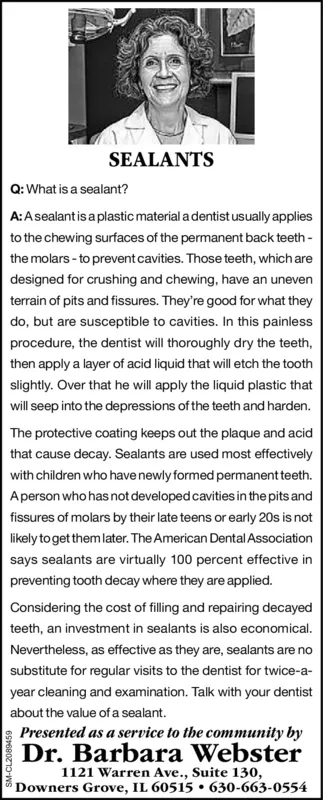Advertisement

-
Published Date
July 13, 2023This ad was originally published on this date and may contain an offer that is no longer valid. To learn more about this business and its most recent offers, click here.
Ad Text
SEALANTS Q: What is a sealant? A: A sealant is a plastic material a dentist usually applies to the chewing surfaces of the permanent back teeth - the molars - to prevent cavities. Those teeth, which are designed for crushing and chewing, have an uneven terrain of pits and fissures. They're good for what they do, but are susceptible to cavities. In this painless procedure, the dentist will thoroughly dry the teeth, then apply a layer of acid liquid that will etch the tooth slightly. Over that he will apply the liquid plastic that will seep into the depressions of the teeth and harden. The protective coating keeps out the plaque and acid that cause decay. Sealants are used most effectively with children who have newly formed permanent teeth. A person who has not developed cavities in the pits and fissures of molars by their late teens or early 20s is not likely to get them later. The American Dental Association says sealants are virtually 100 percent effective in preventing tooth decay where they are applied. Considering the cost of filling and repairing decayed teeth, an investment in sealants is also economical. Nevertheless, as effective as they are, sealants are no substitute for regular visits to the dentist for twice-a- year cleaning and examination. Talk with your dentist about the value of a sealant. Presented as a service to the community by Dr. Barbara Webster 1121 Warren Ave., Suite 130, Downers Grove, IL 60515 630-663-0554 SM-CL2089459 SEALANTS Q : What is a sealant ? A : A sealant is a plastic material a dentist usually applies to the chewing surfaces of the permanent back teeth - the molars - to prevent cavities . Those teeth , which are designed for crushing and chewing , have an uneven terrain of pits and fissures . They're good for what they do , but are susceptible to cavities . In this painless procedure , the dentist will thoroughly dry the teeth , then apply a layer of acid liquid that will etch the tooth slightly . Over that he will apply the liquid plastic that will seep into the depressions of the teeth and harden . The protective coating keeps out the plaque and acid that cause decay . Sealants are used most effectively with children who have newly formed permanent teeth . A person who has not developed cavities in the pits and fissures of molars by their late teens or early 20s is not likely to get them later . The American Dental Association says sealants are virtually 100 percent effective in preventing tooth decay where they are applied . Considering the cost of filling and repairing decayed teeth , an investment in sealants is also economical . Nevertheless , as effective as they are , sealants are no substitute for regular visits to the dentist for twice - a year cleaning and examination . Talk with your dentist about the value of a sealant . Presented as a service to the community by Dr. Barbara Webster 1121 Warren Ave. , Suite 130 , Downers Grove , IL 60515 630-663-0554 SM - CL2089459
